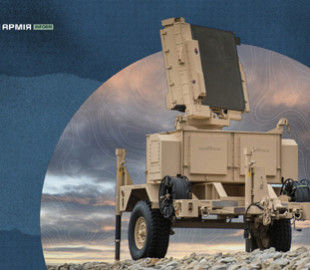Mobile X-band pulsed Doppler radar AN/MPQ-64 F1 Sentinel, developed by Raytheon , is an integral part of the NASAMS air defense system, which strengthened Ukrainian air defense after the Russian full-scale invasion.
ArmiyaInform repeatedly told about how productively these complexes defend the Ukrainian sky in its materials. Therefore, it is quite natural to take a closer look at the "electronic eyes" of this air defense system, which is the AN/MPQ-64 F1 Sentinel radar.
But first, let's remind that NASAMS – it is a medium-range anti-aircraft missile complex developed by the Norwegian company Kongsberg and the American Raytheon. Its acronym stands for Norwegian Advanced Surface to Air Missile System, i.e. “Norwegian Advanced Surface to Air Missile System”. This air defense system is designed to hit air targets at low and medium altitudes under any weather conditions.
Sentinel (“Guardian”, “Defender” or “Guardian” in Ukrainian) is a short-range 3D radar used to detect threats and quickly alert air defense forces. The radar system works in the X-band of radio frequencies (8–12 GHz) and uses the Doppler effect — change in frequency and wavelength during the movement of the source relative to the device. The maximum range is up to 120 km, but effective operation is limited to 75 km.
One of the key features of the AN/MPQ-64 F1 radar is its ability to simultaneously track more than 60 targets while maintaining the ability to constantly search for new threats. This guarantees excellent situational awareness, which is especially important in difficult combat conditions.
Three-dimensional tracking is provided by narrow-beam technology, which provides operators with the detailed data needed to make operational decisions. This radar not only detects targets, but can also classify them, which increases the effectiveness of air defense systems.
200% Deposit Bonus up to €3,000 180% First Deposit Bonus up to $20,000The antenna provides phase-frequency electronic scanning, forming a three-dimensional picture of large surveillance. It is mounted on a rapidly rotating platform (30 revolutions per minute) for rapid 360-degree scanning of space.
The towed platform allows the antenna to be separate from the main unit and operate autonomously, communicating with the fire control center via a broadband fiber optic link, or SINCGARS — military-style single-channel ground radio system used by the US Army.
The developers provided the radar with high resistance to electronic warfare and anti-radar missiles. Sentinel interacts with the architectures of several air and missile defense systems, including the Increment I anti-missile, artillery, and mortar (C-RAM) system to protect friendly aircraft when firing at complex targets.
It should be noted that with In 2022, these radars began to be integrated with the Patriot air defense system, which is known to belong to long-range anti-aircraft systems. Integration takes place with the help of the new American combat control system IBCS (Integrated Air and Missile Defense Battle Command System). She is the "brain" complex air defense system.
The IBCS processes data received from various sources, including satellites and reconnaissance aircraft, and based on this, further decisions are made to open fire.
The radar is powered by a built-in diesel generator with a frequency of 400 Hz. The transmission line to the weapons system consists of a broadband fiber optic cable. This data can also be transmitted to the radar data network.
Weighing in at 1,800 kg, the AN/MPQ-64 F1 is easily transported using various platforms such as all-terrain vehicles, helicopters or mounted on rooftops for increased range.
p>
The mobility of the radar makes it ideal for use in difficult combat conditions that require a quick reaction. The design allows the system to be deployed in less than 15 minutes, which reduces the time required to start work and ensures operational efficiency in combat conditions.

